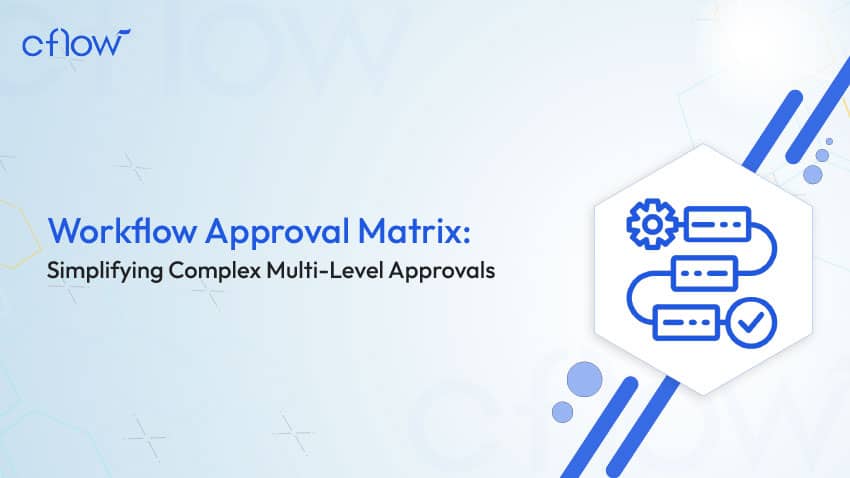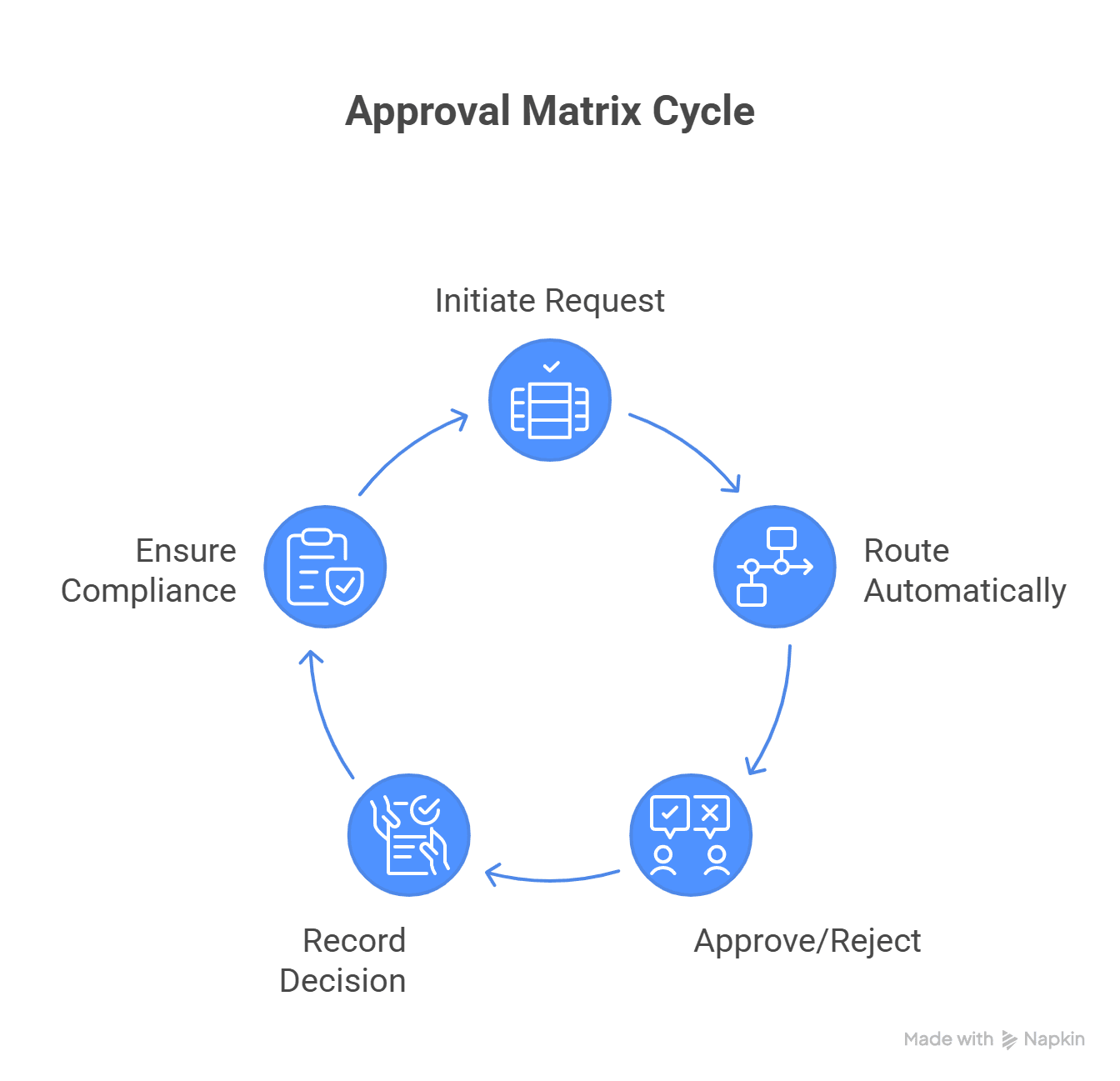Workflow Approval Matrix: Simplifying Complex Multi-Level Approvals

Key takeaways
A workflow approval matrix is essential for scaling decisions across departments without losing control or speed.
It clearly defines approval logic by amount, department, risk, and urgency, reducing confusion and miscommunication.
Organizations using automated approval matrices report improved compliance, reduced cycle times, and audit readiness.
Platforms like Cflow empower teams to design dynamic, no-code approval workflows with built-in policy validation and escalations.
Why Managing Approvals Gets Harder as Organisations Scale
In a growing organisation, managing approvals is rarely a binary decision—it’s a complex process layered with accountability, hierarchy, and risk. What starts as a straightforward “yes” or “no” quickly evolves into a maze of interdepartmental reviews, conditional checks, and policy validations. As headcount increases and financial stakes rise, every approval—whether for a vendor payment, capital expenditure, or hiring request—can involve multiple stakeholders with distinct authority levels.
This fragmentation not only causes bottlenecks but also opens the door to inconsistencies, compliance gaps, and costly delays. Approximately 76% of businesses use automation for standardising daily workflows, while 58% utilise it for data reporting and planning.
In this blog, we explore how a workflow approval matrix helps organisations overcome these challenges with structure, speed, and compliance.
What is a Workflow Approval Matrix?
A workflow approval matrix is a logical framework that determines who approves specific requests within a business process. It outlines conditions—such as department, transaction amount, or project type—that trigger different levels of authorisation.
For example, in a finance department, a payment under $500 might only require a supervisor’s approval, while anything above $5,000 needs CFO clearance. The matrix removes ambiguity, ensuring each request follows a predetermined approval path.
Mature organisations incorporate the matrix into centralised systems that support escalation logic, temporary delegations, threshold-based variations, and even compliance flags when conditions deviate.
Why Do Businesses Need an Approval Matrix?
As organisations grow, so does the complexity of decisions. What once involved a single manager now requires input from finance, legal, procurement, and department heads. In the absence of a formal approval matrix, this complexity becomes a breeding ground for operational chaos. Decisions get delayed, unauthorised actions go unchecked, and financial risks escalate—all because there’s no structured logic guiding who approves what.
The Consequences of Not Having an Approval Matrix
Without a defined approval framework, businesses face three critical issues:
- Duplicate or Missed Approvals: Requests often get routed multiple times or worse, get approved by the wrong authority. This redundancy not only wastes time but also increases the risk of errors.
- Unauthorised Financial Commitments: When approval authority is not clearly assigned, employees may commit to vendors or capital expenses outside their remit—putting budgets, vendor relationships, and financial planning at risk.
- Audit Trail Gaps and Compliance Failures: Regulatory requirements demand traceability and transparency. Without a consistent approval matrix, audit trails are fragmented, making it hard to demonstrate policy adherence or validate decisions during internal or external audits.
How an Approval Matrix Restores Order and Control
A workflow approval matrix acts as a rulebook that defines who approves what, based on logical parameters—role, department, transaction value, location, and process type. Every decision follows a standardised route that’s automated, recorded, and compliant. Instead of chasing signatures or relying on memory, employees can initiate approvals knowing exactly where the request will go and what’s required at each level.
This structure brings several advantages:
- Transparency: Every stakeholder knows their role, and visibility is maintained throughout the process.
- Policy Enforcement: Approval routing aligns with internal governance and budget controls.
- Speed and Accountability: With predefined paths, requests are routed automatically to the right person, reducing manual delays.
Key Components of a Workflow Approval Matrix
A workflow approval matrix should reflect both the complexity of business decisions and the clarity required for operational efficiency. Below are the key components that make the matrix functional, scalable, and audit-ready.
1. Approval Levels
These define who has the authority to approve specific types of transactions. Approval levels are typically based on factors like monetary value, risk level, and transaction category. For instance, a manager may approve expenses under $1,000, while higher-value requests escalate to senior leadership. Clearly defined levels ensure decisions stay within the appropriate authority.
2. Trigger Conditions
Trigger conditions activate the right workflow based on predefined rules. These rules consider variables such as department, request type, or amount. For example, a purchase request above $10,000 from the procurement team might trigger an approval chain involving finance and senior management. These conditions eliminate ambiguity in routing.
3. Routing Logic
Routing logic determines the exact path a request follows through the organisation. It ensures approvals happen in the right sequence or in parallel, depending on the workflow. Conditional routing based on input values makes it easy to tailor the path per use case, reducing manual errors and delays.
4. Escalation Policies
Escalation rules help prevent approval delays by automatically alerting or routing pending requests to higher authorities. If an approver fails to act within a set time frame—say, 48 hours—the workflow can escalate to the next level. This ensures that important requests don’t stall and SLAs are maintained.
5. Roles and Delegations
To maintain continuity, workflows must accommodate temporary changes in personnel. Backup approvers and delegation settings allow another team member to act on behalf of someone on leave. Role-based access ensures users only see and approve what’s relevant to their responsibilities, reducing confusion and risk.
6. Audit Readiness
Every action within an approval matrix must be traceable and policy-compliant. Timestamped logs, decision comments, and user activity histories help organisations maintain full transparency. These records not only support internal governance but also simplify external audits and regulatory reporting.
Common Use Cases for Approval Matrices
Approval matrices play a foundational role in ensuring that business decisions are made with consistency, compliance, and control. They are especially critical in departments that manage high volumes of requests or operate under regulatory scrutiny. Here are some of the most common and high-impact areas where approval matrices are applied:
Procurement
In procurement, approval matrices govern how purchase requests are initiated, evaluated, and finalised. Whether it’s vendor selection, raising a purchase order, or making high-value procurement decisions, each step must align with budget limits and approval hierarchies. For instance, a software subscription under $5,000 may need only departmental approval, while hardware purchases above $20,000 might require cross-functional sign-off from procurement, IT, and finance. This ensures cost control and vendor accountability.
Finance
Finance teams rely heavily on approval matrices to manage sensitive transactions such as invoice approvals, employee reimbursements, and fund disbursements. These matrices define thresholds for who can release payments, approve budget reallocations, or validate vendor bills. For example, an accounts payable team may route invoices above $50,000 to the CFO, while routine payments below that threshold go through a finance manager. This structured approach reduces fraud, enforces policy compliance, and ensures timely processing.
Human Resources (HR)
HR processes like employee onboarding, leave approvals, benefits administration, and training reimbursements benefit significantly from structured approval workflows. An approval matrix helps route requests to the right approvers based on role, location, and budget. For instance, an international relocation expense would follow a different path than a local training course. Automating these approvals ensures a consistent employee experience and reduces administrative back-and-forth.
Information Technology (IT)
IT departments manage assets, licenses, and project budgets—all of which require multi-tiered approvals. An approval matrix ensures that requests for new laptops, cloud services, or software subscriptions are validated by relevant stakeholders. For example, a request for enterprise software licenses might require approvals from IT, procurement, and legal. The matrix prevents unauthorised tool adoption and supports IT budgeting efforts.
Capital Expenditure (CapEx)
Capital-intensive decisions like equipment purchases, infrastructure upgrades, or large-scale projects demand careful oversight. Approval matrices in CapEx workflows route requests based on financial thresholds, return on investment (ROI), and strategic priority. A new facility investment, for instance, may require board-level approval, while department-level upgrades may stop at the COO. This structured oversight ensures that capital is allocated wisely and in alignment with corporate goals.
Benefits of a Workflow Approval Matrix
A workflow approval matrix is a strategic tool that drives faster, more accountable decision-making across the organisation. It standardises approval paths, ensures compliance, and enhances operational efficiency without sacrificing control.
1. Faster Throughput
Automated routing eliminates manual follow-ups and reduces approval delays. Each request flows through a defined path, improving speed and reducing bottlenecks.
2. Stronger Controls
Approval roles and thresholds act as guardrails against policy violations. Unauthorised actions are blocked, and financial discipline is consistently enforced.
3. Better Compliance
Time-stamped logs and tracked decisions make audits easier and more transparent. The matrix ensures every approval aligns with regulatory standards.
4. Scalability
As your business grows, the matrix scales with it—accommodating new roles, teams, and geographies. It adapts without disrupting ongoing operations.
5. Cross-Functional Transparency
A centralised view of request status keeps everyone informed. Teams know who’s responsible, where a request stands, and why delays occur.
Building a Scalable Approval Matrix: Best Practices
Creating an approval matrix that can evolve with your organisation requires more than just defining approvers—it demands strategic design, cross-functional alignment, and continuous refinement. The following best practices ensure your matrix remains flexible, efficient, and future-proof.
1. Conduct a Workflow Audit
Start by identifying which processes generate the most approval delays, bottlenecks, or errors. A workflow audit helps you zero in on high-impact areas—like procurement, reimbursements, or CapEx—where a structured matrix will drive the most value. Use historical data to prioritise which approval paths need automation first.
2. Involve Governance Teams Early
Bring finance, legal, audit, and compliance teams into the design phase. Their input is crucial for defining thresholds, risk categories, and exception-handling rules. Early alignment ensures your matrix meets internal controls and external regulatory standards, avoiding costly rework later.
3. Use Role-Based Logic Over User-Based
Instead of assigning approvals to individual users, assign them by role (e.g., Department Head, Finance Controller). This adds agility—when someone changes roles or leaves the company, the logic remains intact. Role-based routing also supports organisational growth and process standardisation.
4. Set Time-Bound Escalation Paths
Define clear time limits for each approval stage and build automatic escalation rules. If a request isn’t acted upon within a set timeframe (e.g., 48 hours), it should auto-route to the next approver or trigger a reminder. This keeps workflows moving and prevents bottlenecks.
5. Implement Simulation Testing
Before going live, test your matrix in a sandbox environment using real-world scenarios. Simulate approval flows for different departments, transaction types, and exceptions. This helps uncover logic gaps, misrouted flows, or role mismatches that could disrupt operations post-launch.
6. Review Quarterly
Approval needs change as businesses grow or restructure. Set a quarterly cadence to review your approval matrix for relevance and accuracy. Update roles, thresholds, and logic paths to reflect organisational shifts, policy changes, or new regulatory requirements.
End-to-end workflow automation
Build fully-customizable, no code process workflows in a jiffy.
How Cflow Helps Simplify Complex Multi-Level Approvals
Cflow enables organisations to turn fragmented, manual approval processes into structured, scalable workflows. It brings order, speed, and compliance to even the most complex multi-level approvals.
No-Code Workflow Configuration
Cflow’s visual builder allows users to create custom approval flows without writing code. Approvals can be set based on role, value, department, or condition.
Dynamic, Role-Based Logic
Approvals are routed by roles, not individuals, making it easy to adapt to org changes without disrupting the workflow.
Multi-Tier Routing and Escalations
Cflow handles sequential and parallel approvals across departments. SLA-based escalation rules automatically push pending tasks to higher authorities.
Centralised Visibility and Control
Dashboards offer real-time insight into approval status, delays, and exceptions, ensuring transparency across all levels.
Compliance-Ready Records
Every action is time-stamped and logged. Cflow enforces policy rules and creates audit trails for regulatory compliance.
Integrates Across Business Systems
Cflow connects with ERP, HR, and finance platforms to unify approvals across systems—eliminating silos and manual handovers.
With Cflow, businesses gain a centralised platform that simplifies complex approvals while enhancing accountability, agility, and compliance at every level.
Real-World Case Studies
Below are real-world examples of how Cflow enabled companies to simplify complex multi-level approvals and accelerate decision-making.
1. NutriAsia: Automating Capital Expenditure Approvals
NutriAsia Transforms CapEx Approvals with Cflow. NutriAsia was experiencing significant delays in processing Capital Expenditure (CapEx) approvals due to manual workflows using spreadsheets and email. With multiple departments involved and growing request volumes, tracking multi-level approvals became increasingly difficult.
This lack of visibility and control was stalling key investment decisions. Cflow helped streamline the process by introducing an automated, role-based approval matrix. As a result, NutriAsia reduced approval cycle times, improved transparency, and scaled automation across other workflows.
2. L&T IPM: Streamlining Academic Program Approvals
L&T IPM Streamlines Program Approvals with Cflow L&T Institute of Project Management (L&T IPM) struggled with inefficient manual processes for planning and approving academic programs. Excel-based workflows and long email threads led to missed approvals and poor coordination among stakeholders.
Approvals across multiple levels were delayed, affecting overall program delivery. Cflow implemented a configurable, multi-level approval workflow tailored to their needs. This reduced delays, improved visibility, and significantly boosted staff productivity and process efficiency.
Final Thoughts
A workflow approval matrix ensures that organisational controls don’t slow down decision-making but instead guide it. With platforms like Cflow, what was once a static document becomes a living, automated system—adjusting dynamically to your evolving needs. It’s not just about approvals; it’s about empowering your teams to act faster and smarter.
If you’re aiming to scale operations while improving governance, now is the time to build and automate your approval matrix. Sign up for a free trial of Cflow.
FAQs
1. What is the hierarchy of approval matrix?
An approval matrix hierarchy defines levels of authority based on role, department, and transaction value. It ensures each request is routed to the appropriate decision-maker at each stage.
2. What is the approval matrix rule?
Approval matrix rules are logic-based conditions—like amount thresholds or department type—that determine how requests are routed for approval within a workflow.
3. What is the decision-making approval matrix?
It is a structured framework that outlines who makes which decisions in an organisation, promoting clarity, accountability, and policy compliance across complex workflows.
What would you like to do next?
Automate your workflows with our Cflow experts.


